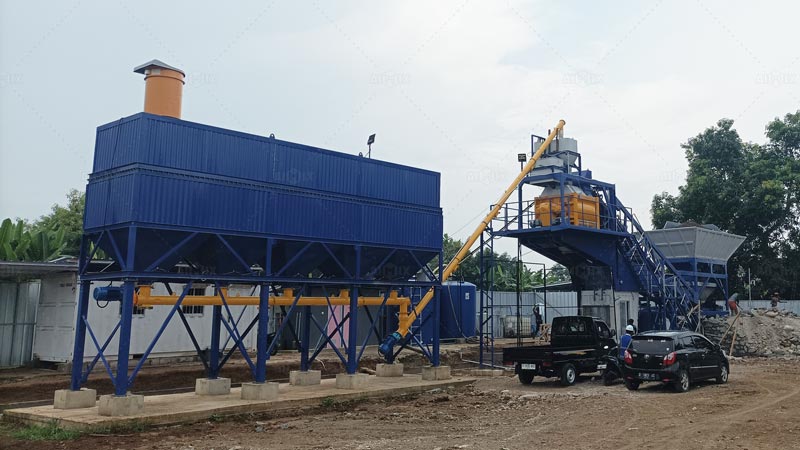The construction industry relies heavily on reliable, efficient equipment for projects of all sizes. Concrete mixing plants, whether stationary or mobile, are vital for producing high-quality concrete efficiently. Small concrete mixing plants, in particular, have gained popularity in recent years due to their relatively low initial investment and the ability to adapt to various project scales. However, one of the crucial considerations for contractors is the long-term holding cost of such plants. In this article, we will explore the investment value of small concrete plants, focusing on how to reduce long-term holding costs and maximize returns on investment.
Understanding the Cost Structure of Small Concrete Plants
When considering a small concrete plant(mini planta de hormigon) for a construction project, contractors must analyze both the upfront costs and the long-term operational costs. While the initial price may be lower compared to larger, more complex concrete plants, the long-term costs are where the real financial impact lies. These ongoing expenses include maintenance, labor, energy consumption, and wear-and-tear on components.
Mobile concrete plants, in particular, offer flexibility by being able to be transported between different project sites, potentially lowering logistics and transportation costs. However, the maintenance and operational costs can still accumulate over time, especially if the equipment is not managed effectively.
The key to reducing these costs is careful planning, efficient operation, and strategic investment in the right equipment.
Key Factors Contributing to Long-Term Holding Costs
1. Maintenance and Repairs
The first and most obvious cost of operating a small concrete plant is maintenance. Like any other heavy machinery, concrete mixing plants require regular servicing and repairs to remain in good working condition. The wear-and-tear of key components, such as mixers, conveyor belts, and electric motors, can lead to significant repair costs over time. Proper maintenance schedules can minimize these costs, but they still need to be factored into the overall investment analysis.
Choosing a reliable brand for the concrete plant(planta de concreto en Chile) is crucial, as it affects the longevity and durability of the equipment. Opting for high-quality parts and components can help reduce maintenance frequency and lower repair expenses.
2. Energy Consumption
Another important consideration is the energy consumption of the concrete plant. Small concrete plants, especially stationary models, can consume a significant amount of electricity to operate the mixing, batching, and transportation processes. Mobile concrete plants may offer more energy-efficient options due to their compact design and advanced technology.
Contractors can optimize energy consumption by investing in energy-efficient motors and automation systems, as well as ensuring that the plant operates at its ideal capacity to avoid overuse of energy.
3. Labor Costs
Labor costs are a significant portion of the operational expenses for concrete plants. For small concrete plants, these costs can be reduced by investing in automated systems, such as computer-controlled batching and weighing systems, which require less manual labor. Furthermore, operators of mobile concrete plants can often perform multiple tasks, such as mixing and transportation, reducing the need for a larger crew on-site.
With fewer personnel needed to operate the plant, contractors can save on wages and reduce the overall operational costs.
4. Equipment Depreciation
As with any equipment, a small concrete plant experiences depreciation over time. The rate of depreciation will depend on factors such as usage frequency, maintenance practices, and market demand. Contractors should consider these factors when evaluating the investment value of a concrete plant, as depreciation will affect the resale value and the overall return on investment.
To reduce the impact of depreciation, contractors can extend the life of their concrete plant through proper maintenance and timely upgrades.
Strategies for Reducing Long-Term Holding Costs
1. Opt for Modular and Mobile Concrete Plants
One effective strategy for reducing long-term holding costs is investing in a mobile concrete plant or modular system. These plants are designed for easy transportation and quick setup, which can significantly lower transportation and installation costs. Additionally, mobile concrete plants(planta de concreto movil) can be used on various job sites, providing flexibility and ensuring that the equipment is fully utilized.
Since mobile plants are typically smaller and more efficient, they tend to consume less energy and require less manpower, leading to reduced operational costs.
2. Focus on Preventative Maintenance
Investing in a robust maintenance program is essential for reducing the long-term costs of owning a small concrete plant. Preventative maintenance schedules can help identify issues before they become costly problems, ensuring that the equipment runs smoothly and efficiently. Regular inspections of key components, such as mixers and conveyors, can prevent unexpected breakdowns that result in downtime and expensive repairs.
By extending the lifespan of the equipment, contractors can maximize their investment and reduce the frequency of costly repairs.
3. Leverage Automation and Technology
Another way to reduce long-term holding costs is to incorporate automation and advanced technology into the operation of the concrete plant. Modern concrete plants often feature automated batching and mixing systems, as well as computer-controlled weighing systems, which can optimize production and minimize human error.
Automation can also reduce the need for labor, lowering overall payroll expenses. The ability to track production and maintenance data in real time through digital systems can help contractors make more informed decisions about equipment usage and maintenance.
Conclusion
Investing in a small concrete plant can be a smart decision for contractors seeking to lower initial investment costs while maintaining high production standards. However, to maximize the investment’s value, it is crucial to consider the long-term holding costs, including maintenance, energy consumption, labor, and depreciation. By choosing the right equipment, implementing efficient operational strategies, and utilizing advanced technologies, contractors can reduce these costs and improve the overall profitability of their construction projects.
Investing in the right concrete plant for your needs, whether it’s a stationary small concrete plant or a mobile concrete plant, will ensure that you get the most out of your equipment while reducing unnecessary costs in the long run.


Comments
No comments yet. Be the first to react!